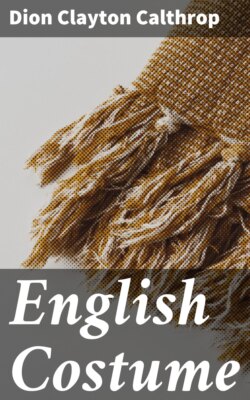Читать книгу English Costume - Dion Clayton Calthrop - Страница 19
На сайте Литреса книга снята с продажи.
ОглавлениеThe learning of the country was shared by the ladies and the clergy, and the influence of Osburgha, the mother of Alfred, and Editha, the wife of Edward the Confessor, was paramount among the noble ladies of the country.
The energy of the clergy in this reign was more directed to building and the branches of architecture than to the more studious and sedentary works of illumination and writing, so that the sources from which we gather information with regard to the costume in England are few, and also peculiar, as the drawing of this date was, although careful, extremely archaic.
Picture the market-town on a market day when the serfs were waiting to buy at the stalls until the buyers from the abbey and the castle had had their pick of the fish and the meat. The lady’s steward and the Father-Procurator bought carefully for their establishments, talking meanwhile of the annual catch of eels for the abbey.
Picture Robese, the mother of Thomas, the son of Gilbert Becket, weighing the boy Thomas each year on his birthday, and giving his weight in money, clothes, and provisions to the poor. She was a type of the devout housewife of her day, and the wife of a wealthy trader.
The barons were fortifying their castles, and the duties of their ladies were homely and domestic. They provided the food for men-at-arms, the followers, and for their husbands; saw that simples were ready with bandages against wounds and sickness; looked, no doubt, to provisions in case of siege; sewed with their maidens in a vestiary or workroom, and dressed as best they could for their position. What they must have heard and seen was enough to turn them from the altar of fashion to works of compassion. Their houses contained dreadful prisons and dungeons, where men were put upon rachentegs, and fastened to these beams so that they were unable to sit, lie, or sleep, but must starve. From their windows in the towers the ladies could see men dragged, prisoners, up to the castle walls, through the hall, up the staircase, and cast, perhaps past their very eyes, from the tower to the moat below. Such times and sights were not likely to foster proud millinery or dainty ways, despite of which innate vanity ran to ribbands in the hair, monstrous sleeves, jewelled shoes, and tight waists. The tiring women were not overworked until a later period, when the hair would take hours to dress, and the dresses months to embroider.
In the town about the castle the merchants’ wives wore simple homespun clothes of the same form as their ladies. The serfs wore plain smocks loose over the camise and tied about the waist, and in the bitter cold weather skins of sheep and wolves unlined and but roughly dressed.
Cases for the Hair.
In 1154 the Treaty of Wallingford brought many of the evils to an end, and Stephen was officially recognised as King, making Henry his heir. Before the year was out Stephen died.
I have not touched on ecclesiastical costume because there are so many excellent and complete works upon such dress, but I may say that it was above all civil dress most rich and magnificent.
I have given this slight picture of the time in order to show a reason for the simplicity of the dress, and to show how, enclosed in their walls, the clergy were increasing in riches and in learning; how, despite the disorders of war, the internal peace of the towns and hamlets was growing, with craft gilds and merchant gilds. The lords and barons fighting their battles knew little of the bond of strength that was growing up in these primitive labour unions; but the lady in her bower, in closer touch with the people, receiving visits from foreign merchants and pedlars with rare goods to sell or barter, saw how, underlying the miseries of bloodshed and disaster, the land began to bloom and prosper, to grow out of the rough place it had been into the fair place of market-town and garden it was to be.
Meanwhile London’s thirteen conventual establishments were added to by another, the Priory of St. Bartholomew, raised by Rahere, the King’s minstrel.
